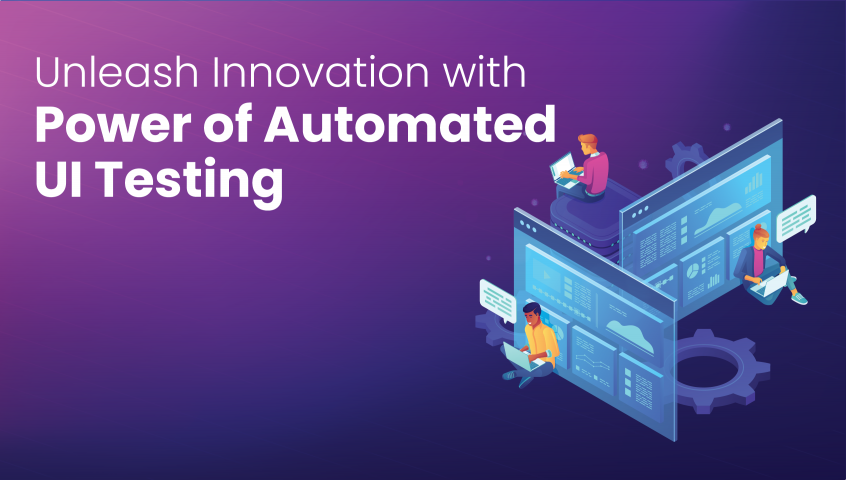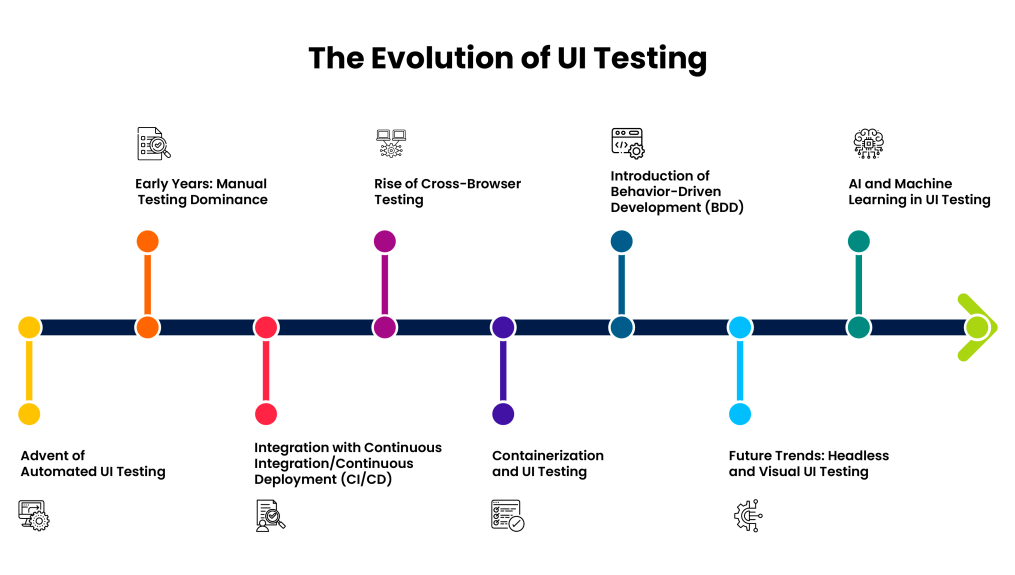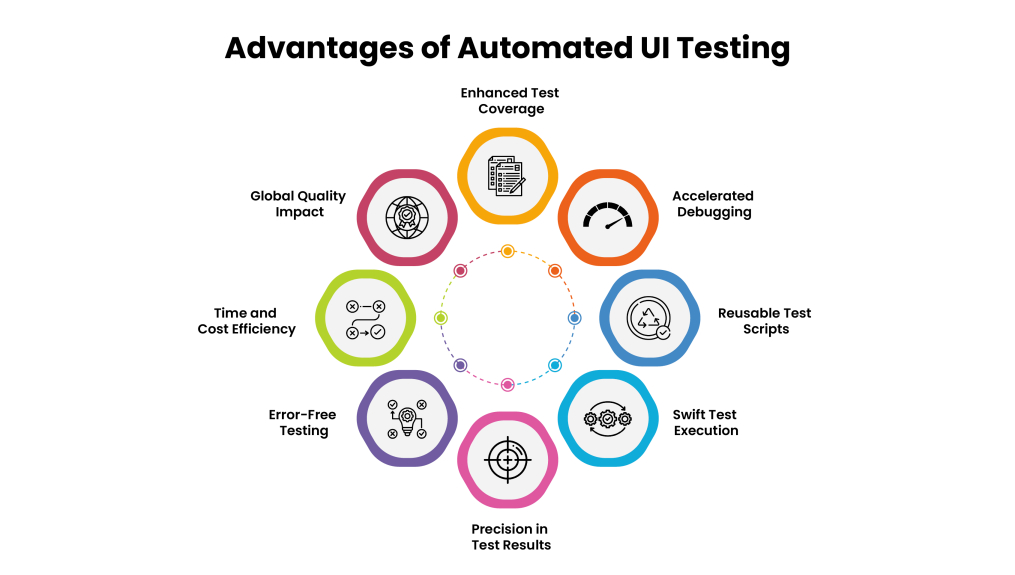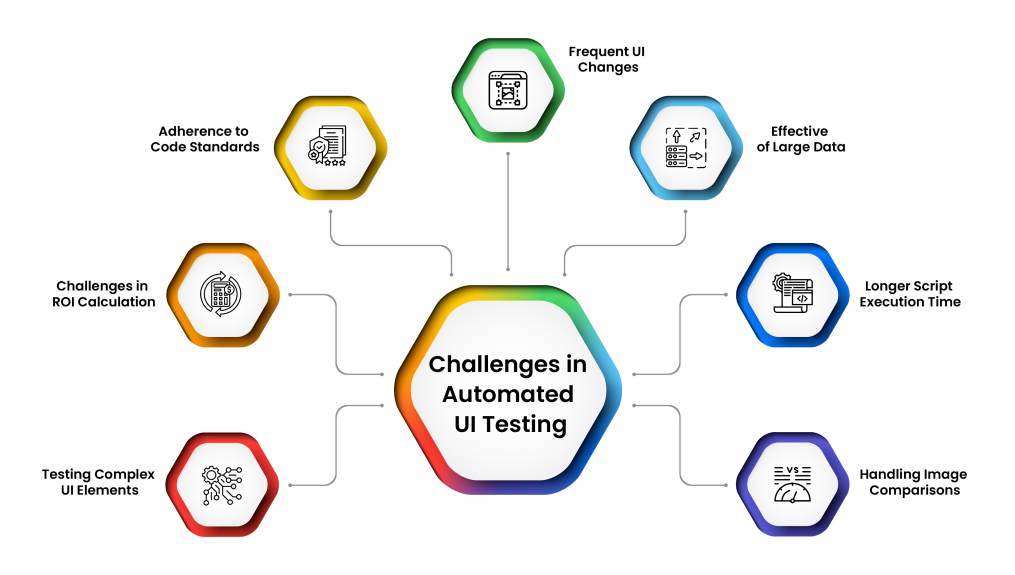
The field of software development is not just evolving—it’s transforming. Innovation here is not just a buzzword but a critical requirement. The capacity to craft cutting-edge products and services is deeply connected to the efficiency of development processes. In this dynamic landscape, staying ahead requires a strategic focus on fostering innovation by optimizing development methodologies.
Enter Automated UI Testing (AUT)—a strategic enabler of quality and efficiency in software delivery. In this article, we delve into the significant impact of AUT on driving innovation within software development.
Understanding Automated UI Testing
Automated UI Testing goes beyond manual testing, which relies heavily on human intervention. It involves using specific tools or frameworks, such as Selenium or QuickTest Professional, to convert manual testing efforts into an automated, efficient process. This method is essential for verifying UI functionality, including user navigation, UI workflows, testing button logic, and input field validation.
The strategic advantage of AUT lies in its ability to reduce the time and human effort required for thorough UI testing. Instead of manually checking every aspect of the user interface, teams can develop test scripts tailored to emulate specific user scenarios. These scripts are not only efficient but also reusable, providing consistent and reliable testing outcomes even as code is modified or new features are introduced.
Web UI Testing vs. Mobile UI Testing: A Strategic Comparison for Optimized User Experience
In the realm of Automated UI Testing, two distinct domains stand out—Mobile UI Testing and Web UI Testing. Each serves a unique purpose and presents different challenges and considerations. As we embrace a mobile-first world and the ubiquity of web applications, understanding these differences becomes a strategic imperative for CXOs.
Mobile UI Testing focuses on the functionality of mobile applications across various devices, operating systems, and orientations. It is vital to ensure that mobile apps deliver a seamless user experience, which is critical for maintaining competitive advantage in the market. This testing type includes:
- Compatibility Testing: Testing on different devices and OS versions to guarantee consistent app performance.
- Responsive Design: Ensuring the app's UI adapts to different screen sizes and orientations.
- Gesture Testing: Verifying the app responds accurately to touch gestures—essential for an intuitive user experience.
- Localization Testing: Checking the app's operation with different languages and regional settings to cater to a global audience.
- Performance Testing: Ensuring smooth navigation and quick responsiveness to keep users engaged.
- Usability Testing: Validating that the app is user-friendly and navigation is intuitive.
- Accessibility Testing: Making sure the app is usable by people with a wide range of disabilities, thus broadening the user base.
Web UI Testing, on the other hand, ensures that websites and web applications function correctly across various browsers and devices. It is crucial for organizations to provide a consistent and reliable web presence. This testing type includes:
- Browser Compatibility: Verifying that web applications operate flawlessly across different web browsers, such as Chrome, Firefox, Safari, and IE.
- Responsive Web Design: Ensuring that web content is displayed correctly and efficiently on various devices, which is key to user retention.
- Form Validation Testing: Focused on data entry and submission processes to prevent user frustration and drop-off.
- Localization Testing: Includes checking how websites handle localization, which can influence how users interact with the content.
- Performance Testing: Monitoring page load times and overall web performance, which can significantly affect user satisfaction and SEO rankings.
- Usability Testing: Ensuring a consistent and intuitive web user experience.
- Navigation Testing: Guaranteeing seamless navigation across different web pages, which is essential for user engagement.
- Accessibility Testing: Ensuring web accessibility, which is not only a legal compliance issue but also expands market reach.
Both Web UI Testing and Mobile UI Testing are pivotal in delivering a superior digital experience—a cornerstone in today's customer-centric business environment. By integrating these testing strategies, organizations can ensure that their digital touchpoints are robust, user-friendly, and inclusive, aligning with both business objectives and customer expectations.
The Strategic Evolution of UI Testing: Accelerating Quality and Innovation

UI testing has undergone a transformative evolution, catalyzed by technological advancements and a relentless pursuit of software quality. Each phase of its development marks a significant leap in efficiency, reliability, and scalability, reflecting the changing landscape of business technology needs.
- Early Years: Manual Testing Dominance Initially, UI testing was a manual, labor-intensive process with testers rigorously validating functionality and identifying issues. While thorough, this method was time-consuming and scaled poorly, posing a bottleneck for rapid development and deployment.
- Advent of Automated UI Testing The push for faster development cycles led to the advent of automated UI testing. Tools like Selenium, introduced in 2004, automated repetitive test scenarios, accelerating testing processes and enhancing precision—key for maintaining competitiveness in fast-paced markets.
- Rise of Cross-Browser Testing As web browsers proliferated, ensuring a consistent user experience became critical. Cross-browser testing emerged, using automated scripts to validate application behavior across browsers, directly impacting user satisfaction and broadening market reach.
- Integration with CI/CD Incorporating UI testing into Continuous Integration/Continuous Deployment (CI/CD) pipelines represented a strategic advancement, facilitating early detection of UI issues and significantly reducing the cost and time-to-market for fixing defects.
- Introduction of Behavior-Driven Development (BDD) The integration of BDD principles into UI testing bridged gaps between technical and non-technical stakeholders, enhancing communication and aligning product development with user requirements and business goals.
- Containerization and UI Testing Containerization standardized test environments across development stages, minimizing discrepancies and enhancing the reliability of UI tests—a boon for maintaining consistent quality standards.
- AI and Machine Learning in UI Testing The integration of AI and ML, with tools like autoMagiQ, has propelled UI testing into a new era. These technologies offer intelligent test script generation and dynamic adaptability, reducing maintenance overhead and ensuring comprehensive test coverage.
- Future Trends: Headless and Visual UI Testing Looking to the future, headless testing promises enhanced efficiency, while visual UI testing, powered by AI image recognition, aims to ensure pixel-perfect UIs. These innovations are set to redefine the benchmarks for software quality and user experience.
As we navigate these advancements, it is imperative for CXOs to recognize the strategic importance of UI testing evolution—not just as a technical imperative but as a cornerstone for delivering exceptional user experiences, driving market differentiation, and securing a competitive edge in the digital economy.
Strategic Advantages of Automated UI Testing in Agile Environments

Incorporating Automated UI Testing (AUT) within Agile software development frameworks confers strategic advantages that extend beyond technical benefits to impact the core business objectives:
- Enhanced Test Coverage: AUT enables teams to expand test coverage significantly, leading to a more robust examination of the application’s functionality. This comprehensive coverage is crucial for mitigating risks and ensuring that the product meets the high-quality standards demanded in competitive markets.
- Accelerated Debugging: With broader test coverage, AUT facilitates faster identification and resolution of issues, thereby improving the development cycle's efficiency. This rapid debugging capability translates to shorter time-to-market, a key factor in achieving business agility.
- Reusable Test Scripts: The ability to reuse test scripts makes AUT a scalable solution, optimizing resources when updating code or rolling out new features. This reuse is synonymous with operational efficiency, directly correlating with reduced operational costs and increased ROI.
- Swift Test Execution: The quick execution of automated UI tests as compared to manual efforts results in faster test cycles, enabling organizations to accelerate their development timelines and respond promptly to market demands or changes.
- Precision in Test Results: Accurate and reliable test results reduce the incidence of software defects that could tarnish customer trust and brand reputation. Precision is not just a technical necessity but a foundational element of customer satisfaction.
- Error-Free Testing: By eliminating the risk of human error, AUT ensures consistent and reliable test executions, reinforcing the brand's promise of quality and reliability.
- Time and Cost Efficiency: The time and cost savings from AUT are transformative, converting into strategic investments in innovation and customer experience enhancements.
- Global Quality Impact: The Global Quality Report highlights that organizations adopting test automation benefit from expedited bug detection and increased test case reuse. This global impact is a testament to AUT's role in aligning software quality with business outcomes.
By embracing AUT, organizations do not just streamline their software development lifecycle; they invest in a quality assurance strategy that drives market differentiation, operational excellence, and sustainable growth.
Navigating Challenges in Automated UI Testing for Business Continuity
In the pursuit of digital excellence, Automated UI Testing (AUT) is not without its challenges. These hurdles, if not strategically managed, can impede the delivery of seamless user interactions and robust web application functionality. Recognizing and mitigating these challenges is critical for maintaining business continuity and product quality:
- Frequent UI Changes: The dynamic nature of customer demands and rapid technological change requires continuous adaptation. The challenge for testers is to maintain UI test scripts amidst frequent updates without causing disruptions, impacting the speed of delivery and market responsiveness.

- Effective Handling of Large Data: Large-scale projects with complex scenarios demand proficient error handling in AUT. The ability to manage vast data volumes without compromising on efficiency is critical for sustaining operational momentum and ensuring product reliability.
- Longer Script Execution Time: While automation aims to expedite testing, lengthy script execution can counteract these benefits, affecting the agility of the development process. Efficient management of test scripts is thus essential for upholding swift product iterations and time-to-market.
- Handling Image Comparisons: Accurate image comparisons are vital for ensuring the graphical integrity of the user interface. The capacity to detect minute pixel variations directly influences the user experience, reflecting on the brand's attention to detail and commitment to quality.
- Testing Complex UI Elements: As web technologies evolve, so do the complexities of UI elements. Successfully testing intricate components like embedded frames or interactive graphics is paramount for the technological sophistication of products.
- Adherence to Code Standards: Inconsistent coding practices can lead to difficulties in test maintenance, impeding the scalability and evolution of AUT scripts. Standardized coding is not just a technical issue; it is fundamental to long-term strategic development and knowledge transfer within the organization.
- Choosing the Right Automation Tool: The selection of a suitable AUT tool is pivotal. It requires a balance between technical capability, cost-effectiveness, and alignment with project goals. A strategic choice here not only saves resources but also ensures that the organization is equipped to meet current and future testing demands.
For CXOs, the imperative is clear: understanding these challenges is essential for devising strategies that ensure resilience in product development cycles, safeguarding the user experience, and ultimately securing the organization's competitive advantage in the market.
Strategic Best Practices for Maximizing Value from Automated UI Testing
Automated UI Testing (AUT) is integral to the software development lifecycle, directly impacting product quality and market agility. To harness its full potential, organizations must follow strategic best practices that align with overarching business objectives:
- Strategic Test Automation: Select tests for automation based on criteria that promote business efficiency: repetitive nature, susceptibility to human error, and relevance to core functions. This strategic approach ensures that automation is leveraged for maximum ROI.
- Collective Ownership: Encourage cross-functional team involvement in AUT to foster a culture of quality and collaborative problem-solving, enhancing product integrity and accelerating development.
- Reliability of Test Suites: Prune unstable tests from regression packs to maintain a suite that consistently yields precise results, enhancing the credibility of testing outcomes and supporting informed decision-making.
- Tool Selection Aligned with Business Goals: Choose testing frameworks or tools that align with the technical requirements and business goals of the project, whether open-source or commercial, to ensure seamless integration and scalability.
- Real Device Testing for Authentic Results: Test on actual devices and browsers to capture true user experiences, addressing the nuances of device fragmentation. Utilizing cloud-based testing platforms can extend testing capabilities without compromising on authenticity.
- Comprehensive Test Records for Enhanced Debugging: Keep detailed logs of test executions to simplify the debugging process. Tools with mechanisms for capturing test artifacts like screenshots or videos can significantly reduce time-to-resolution.
- Data-Driven Testing for Informed Insights: Employ data-driven testing to handle complex scenarios and analyze extensive data sets. This practice supports thorough testing and contributes to data-informed business strategies.
- Early and Continuous Testing for Agile Responsiveness: Begin testing early in the development cycle and conduct it frequently to identify and rectify issues swiftly. This proactive approach reduces remediation costs and aligns with the principles of Agile methodologies.
- Invest in Reporting for Strategic Insights: Develop a robust test reporting infrastructure to deliver detailed and actionable insights after each test cycle. Well-organized reports aid in strategic planning and continuous improvement initiatives.
Adopting these best practices in AUT is not merely a technical exercise—it is a strategic investment. For CXOs, these practices underpin the ability to deliver high-quality products efficiently and responsively, ensuring that the organization remains competitive and agile in a dynamic market.
Final Word: Strategic Implications of Automated UI Testing for Future-Ready Enterprises
The strategic value of Automated UI Testing (AUT) in driving enterprise efficiency and instilling a culture of quality is unequivocal. In the vanguard of technological advancement, AUT is a pivotal force in redefining the paradigms of software development through enhanced efficiency, unwavering precision, and a dedicated pursuit of excellence.
autoMagiQ stands at the forefront of this transformation, leveraging codeless automation powered by the latest AI and ML models. This innovative platform has been instrumental in achieving a significant 70% increase in release confidence, expediting release testing by 30%, and fostering smarter collaboration with a 25% improvement. These metrics speak volumes, illustrating how autoMagiQ is reshaping the test automation landscape by streamlining script development and maintenance, thereby optimizing continuous integration and continuous deployment (CI/CD) operations.
Beyond its technical prowess, autoMagiQ makes automation more accessible to a broader audience, boasting an intuitive interface that empowers non-technical users. Its efficiency is further underscored by a notable 65% increase in test coverage, illustrating the comprehensive nature of its testing capabilities. With features like Auto Healing, autoMagiQ fortifies testing processes, cementing its position as a transformative agent in AI-driven test automation and guiding enterprises towards unmatched operational efficiency and market excellence.
As the business landscape evolves, autoMagiQ delivers a competitive edge through revolutionized AUT, ensuring that organizations are not just keeping pace but setting the pace. For those ready to unlock the full potential of transformative test automation, contact info@qentelli.com and embark on a journey towards a future where efficiency and quality are the benchmarks of success.

